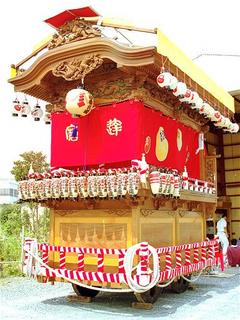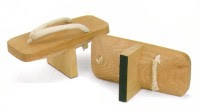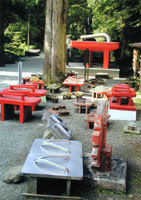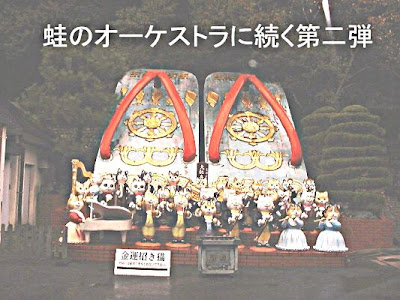. Legends about Mikoshi .
:::::::::::::::::::::::::::::::::::::::::::::::::::::::::::::::::::::::::::::::::::::::::::::::::::::
Festival Float with Daruma
Daruma-Ren だるま連、祭り

平成7年(1995年)小池工務店により解体修理を行う。
特に腰板の額縁を新品に交換することで屋台のガタつきを直した。
屋台解体日=平成7年(1995年)1月17日~阪神淡路大震災の日
http://www.ne.jp/asahi/fukude/matsuri/lst/14k/14k.htm
http://www.ne.jp/asahi/fukude/matsuri/grp/mya/mya.htm
民芸品調の卓上祭り屋台
遠州は屋台祭りが盛んな地方として知られていますが、関連の民芸品が少ないことから今回民芸品調のお祭りグッズとしてミニ屋台の制作を企画。岐阜県の専門工房に依頼し3ヵ年弱の期間を費やしてこのたび完成となりました。
掛塚を発祥地として天竜川流域各地に見られる屋台で、当地福田・掛塚および天竜市二俣の3つをモデルにして各特徴を表現し、小さくても雰囲気を感じさせる形になるよう留意しています。
http://www.ne.jp/asahi/fukude/matsuri/grp/mya/mdl/mdl.htm
danjiri 山車(だんじり)
yatai 山車(やたい / 屋台)
. dashi 山車(だし)festival float
is a kigo for all summer.
The Chinese characters signify a mountain on a cart.
:::::::::::::::::::::::::::::::::::::::::::::::::::::::::::::::::::::::::::::::::::::::::::::::::::::
岸和田だんじり Kishiwada Danjiri Festival
畑町のだんじり
Daruma float from Hata-Cho

Look at more beautiful carvings of the floats:
source : 桜井の駅
:::::::::::::::::::::::::::::::::::::::::::::::::::::::::::::::::::::::::::::::::::::::::::::::::::::
Danjiri Matsuri Festivals だんじり祭り
岸和田 Kishiwada (Osaka)
八百津
泉州
灘のだんじり祭り
西浦だんじり祭り
堺市鳳だんじり祭り
南河内だんじり祭り
. . . CLICK here for Photos !
:::::::::::::::::::::::::::::::::::::::::::::::::::::::::::::::::::::::::::::::::::::::::::::::::::::


Kishiwada Danjiri Festival, Osaka
September, on the "Respect for the Aged Day"
Danjiri festivals are common throughout Japan, but if you say
"Danjiri Matsuri" (festival) to a Japanese, there is one festival that will come to mind: the violent, exuberant mayhem that takes place every September in Kishiwada, Osaka.
The "danjiri" are the large wooden floats, or portable shrines, that are pulled around a pre-set route on the day of the festival. These shrines are kept in storage for a year and are quite beautiful.
Prior to the festival, there are ceremonies and prayers. The ornate shrine is taken out and readied; then the fun starts.
Where is the Danjiri Festival?
The Danjiri Festival is held in Kishiwada City, Osaka. Kishiwada is a working class castle town that was rural until recently. Today it is a suburb south of the city of Osaka, not far from Kansai International Airport.
What is the Danjiri Festival?
The Danjiri Matsuri dates to the 16th century, and is believed to have its origins in the "Inari Matsuri" that was held in 1703. Like many fall festivals, it is essentially a harvest festival to pray for a good harvest. It was created by the Lord of Kishiwada Castle and has always had a wild side to it.
In the past, that could have been said about most festivals in Japan. In the post-war period, however, festivals, like most aspects of Japanese life, have become tamer affairs. The good folk of Danjiri however continue to resist this, and it remains a dangerous festival with several deaths not uncommon each year.
The reason for this is that men stand atop the floats as they weave and turn down narrow streets. These men are sometimes thrown off and crushed below.
source : www.japanvisitor.com
:::::::::::::::::::::::::::::::::::::::::::::::::::::::::::::::::::::::::::::::::::::::::::::::::::::
Iga Ueno Danjiri Museum
伊賀上野だんじり会館
One of Ueno city's big annual events is the 400 year-old
Ueno Tenjin festival 上野天神祭り held between October 23rd to 25th. Originally a sacred agricultural ritual, the festival has elaborate portable shrines and demon-costumed revellers parading in the streets, but a main feature is the nine danjiri carted through the city. The danjiri is a type of dashi, a traditional Japanese festival float on wheels. When not being used in the festival, the Iga Ueno Danjiri Museum houses three of these floats for public viewing.
The three danjiri floats are encased in a large round glass-walled exhibition room, set about with life-sized models reenacting a festival scene. The floats are mounted on a turntable to make it possible to see them from every angle. As it is, visitors are able to walk and see completely around the showcase from the first floor, as well as partway from above the second.
source : The Yamasa Institute
. . . CLICK here for Photos of the museum!
. . . CLICK here for Photos of the festival!
上野天神祭りのだんじり
:::::::::::::::::::::::::::::::::::::::::::::::::::::::::::::::::::::::::::::::::::::::::::::::::::::
Awaji Danjiri Matsuri 淡路だんじり祭り
Danjiri festival at Awaji Island, Hyogo
淡路島.賀集八幡神社春祭りだんじり

quote
Danjiri and Danjiri Chorus
Awaji Island has a profusion of festivals.
There is said to be a total of 300 danjiri in the greater Awaji area. The main is the futon danjiri 布団だんじり with five layers of red futons. The danjiri are pulled around by shrine parishioners in spring and fall.
Created as a group performance based on puppet shows as a sideshow for festivals, the danjiri chorus is also known as jorurikuzushi. The chorus skillfully takes highlights of the story and puts melodies to them. The songs are arranged using danjiri taiko drums and clappers, and there are chorus tsurebushi and solos called puppet katarikomi like storytelling and furi like fork ballad. Katari is placed in the intervals of the chorus and solos.
Many chorus groups have sprung up recently and contests are held.
The singing is now considered a folk art of Awaji.
source : www.yumebutai.org
だんじりは伝統工芸 ... the festival float is an important traditional folk art
source : awajidanjiri.jimdo.com

miniature of a danjiri futon float
It was made by 肥田利一 from 生穂町 and is not made any more.
futon taikodai 太鼓台 Futon drum float
. chossa taikodai ちょっさ太鼓台 Chossa Drum Futon Float . Sanuki, Kagawa
and more details about these futon floats.

mikoshi with kokeshi wooden dolls こけしみこし
. kokeshi こけし wooden dolls .

Mikoshi Daruma
. Regional Folk Toys from Japan .
:::::::::::::::::::::::::::::::::::::::::::::::::::::::::::::::::::::::::::::::::::::::::::::::::::::
Suimu Jinja Mikoshi makuri 水無神社 神輿まくり
(スイムジンジャ)
Shrine festival where simple wooden mikoshi, made anew every year, are paraded through town for two days and then
thrown on the road, forward and sideways, with people standing on them, jumping off in the last moment . . .

Suimu Shrine (水無神社) is located in Kiso, Nagano Prefecture. Record said, it was established in the middle of the 13th century. It has thousand years old Hinoki Trees. Inside of the hall, there are many beautiful large Ema votive tablets. It has been respected by the people of Kiso as the guardian of the valley.
The most famous festival Mikoshimakuri, takes place on July 23.
Kiso Fukushima 木曽福島町内 Nagano
CLICK for more photos !
- source : www.nanchara.net/mikoshimakuri -
Minashi Jinja 水無神社
located in the city of Takayama, Gifu Prefecture, Japan. The kanji for the shrine are also sometimes read as Suimu. The full name is Hida Ichinomiya Minashi Shrine (飛騨一宮水無神社 Hida Ichinomiya Minashi Jinja), as it was once the main shrine of Hida Province.
. . . believed that it was constructed during the reign of Emperor Seiwa during the late-9th century.
Because of firebombing activities during World War II, Minashi Shrine served as a refuge for Atsuta Shrine's Kusanagi from August 21 to September 19, 1945.
- - - More in the WIKIPEDIA !
:::::::::::::::::::::::::::::::::::::::::::::::::::::::::::::::::::::::::::::::::::::::::::::::::::::

photo source : ikuta blog
だんじりを桜の下に引き出して
danjiri o sakura no shita ni hikidashite
they pull
the danjiri float
below the cherry blossoms
Oe Nobuki 大恵宣樹 from Iga, Ueno
http://www.itoen.co.jp/new-haiku/17/kasatoku03.html
:::::::::::::::::::::::::::::::::::::::::::::::::::::::::::::::::::::::::::::::::::::::::::::::::::::
mikoshi 神輿、御輿 portable shrine
kigo for all summer



Daruma Mikoshi だるま神輿
. Kawagoe Daruma Mikoshi 川越だるま神輿 .

source : popeye.sakura.ne.jp/saitama...
Kawagoe dashi 川越山車 festival float from Kawagoe
:::::::::::::::::::::::::::::::::::::::::::::::::::::::::::::::::::::::::::::::::::::::::::::::::::::
. Oita Folk Art - 大分県 .
Nakatsu mikoshi 中津神輿 Nakatsu Festival Float

source : www.asahi-net.or.jp
The mikoshi is modelled from the Nakatsu Gion Festival 中津祇園祭り.
This toy tradition is no longer alive.
And
. akaheko tenjin 赤へこ天神 Tenjin sama with a red robe . - clay doll
- quote -
Nakatsu Gion Festival 中津祇園祭り
This festival has 570 years of tradition and is designated as an intangible folklore cultural asset by Oita prefecture. There will be fireworks on the first day.
On the 2nd day (morning parade) and the 3rd day (returning parade) floats called Gionguruma will parade through Fukuzawa street.
Many events are held during the festival. There are Floats parading around and dancing all over the city while the festival is held.
- source : www.visit-oita.jp -

. . . CLICK here for more Photos !
:::::::::::::::::::::::::::::::::::::::::::::::::::::::::::::::::::::::::::::::::::::::::::::::::::::

source : koshi/shurui.html
. WKD : Kobayashi Issa 小林一茶 .
輿の花盗人よぬす人よ
o-mikoshi no hana-nusubito yo nusubito yo
a blossom thief
in a fancy palanquin!
a thief!
Tr. Chris Drake
This hokku was written in the 1st month (February) of 1813, when Issa had returned to his hometown and was preparing to engage in the final strenuous negotiations with his mother-in-law and younger half brother over his inheritance. It seems possible to see the blossom thief as, on one level, an self-ironic image of Issa himself returning to "blossom-steal" his inheritance back from the people who have been keeping it from him. The exclamations might be his ironic imagined representations of the thoughts or whispered remarks of his mother-in-law and the many villagers in his hometown who consider him a greedy, pushy outsider. Even so, as a blossom thief and not an actual thief, Issa expects to be forgiven if he persists.
The most immediate image, however, is praise for a very beautiful cherry tree in full bloom. A thief of blossoms -- usually of cherries but sometimes of plums or other blossoms -- means someone who breaks off a blossoming sprig and takes it home. Popular renga grew out of linked verse festivals held under cherry trees in full bloom (hana-no-moto) in the 12th and 13th centuries, when the custom of taking home a sprig of cherry blossoms was tolerated to a certain extent for religious reasons, since the sprig was to believed to be part of the body of the cherry-tree god, and the sprigs were worshiped in people's homes. The custom continued over the centuries.
The term "blossom thief" also came to refer to doing something for the sake of great beauty or value that ordinarily wouldn't be allowed. For example, prince Atsumichi (981-1007) wrote the following waka when he visited the mansion of the aristocrat and poet Fujiwara Kintou bearing a sprig of cherry blossoms for his host:
If my name
be Blossom Thief
so be it!
I break off only
a single branch
The prince visited with his new lover, the famous woman poet Izumi Shikibu, who is doubtless the greatest blossom of all in the poem, though she is not mentioned directly. The relationship was a bit scandalous, since a short time earlier Izumi Shikibu had been the lover of prince Atsumichi's older half-brother, who suddenly died of the plague, making prince Atsumichi's actions a bit thief-like. Still, Izumi Shikibu is such a superb poet and person that the prince feels sure he will be forgiven.
In Issa's hokku, many people in his hometown are probably breaking off sprigs with cherry blossoms on them to take home with them, but Issa focuses on an expensive, decorated palanquin. The character Issa uses (輿) is usually read o-mikoshi, the special palanquin of the emperor or a god that is carried on the shoulders of many men, and this is the reading of the editors of Issa's collected works. Issa might also be using the term ironically to refer to any pompously luxurious palanquin. The scholar Maruyama Kazuhiko, however, reads norimono, which is also possible. A norimono was a special luxurious palanquin hanging from a thick, horizontal beam carried by two carriers, one in front and one in back, that had sliding doors on the sides, as opposed to an ordinary palanquin that was open at the sides or often simply a seat hanging from a pole.
In Issa's time only a few people were allowed to ride in an enclosed palanquin: high-ranking samurai, high-ranking monks, herbal and/or acupuncture doctors, women, children, and commoner males who had paid to get special permission from the authorities. I doubt Issa is referring to the emperor, and unless there is a festival going on, it wouldn't be a palanquin carrying a god. It seems likely that Issa is referring to someone of rank or power who has stopped beneath the tree because of its striking beauty and is breaking off a sprig to carry with him or her, probably as a gift to someone who hasn't been able to see the tree. The tone of the hokku is exclamatory, as if Issa were pointing out a shocking crime in progress.
Actually it must be mock-exclamatory, since Issa is at the same time suggesting that this cherry tree is so extremely beautiful that even people who usually ride hidden inside fancy palanquins are willing to get out and act like an ordinary commoner blossom thief. There is no doubt some social satire here, but Issa is also expressing his highest praise for the tree, which is able to make people of all classes humble before it. This is consistent with Issa's usual view that all humans of whatever class are equal in the eyes of Amida.
Chris Drake
:::::::::::::::::::::::::::::::::::::::::::::::::::::::::::::::::::::::::::::::::::::::::::::::::::::
. Float with Dragon Decoration .
From Omi Hachiman Sagicho Festival 近江八幡 左義長まつり
. Matsuyama no mikoshi 松山のみこし mikoshi models .
Ehime
. otabisho, o-tabisho 御旅所 / お旅所 sacred resting point .
for the mikoshi during a procession
.......................................................................

santai mikoshi 三体みこし three mikoshi
for the Gion Festival of Onomichi 尾道祇園祭
. Hiroshima Folk Art - 広島県 .
.......................................................................
Shizuki Mikoshi 志筑神興
. Hyogo Folk Art - 兵庫県 .
. WKD : Festivals of Japan
. WKD : mikoshigusa 神輿草(みこしぐさ) mikoshi plant .
Geranium nepalense. cranesbill
. Legends about Mikoshi .
[ . BACK to WORLDKIGO . TOP . ]
[ . BACK to DARUMA MUSEUM TOP . ]
- #mikoshi #danjiri #float -
:::::::::::::::::::::::::::::::::::::::::::::::::::::::::::::::::::::::::::::::::::::::::::::::::::::








































